We may not have the course you’re looking for. If you enquire or give us a call on 01344203999 and speak to our training experts, we may still be able to help with your training requirements.
Training Outcomes Within Your Budget!
We ensure quality, budget-alignment, and timely delivery by our expert instructors.
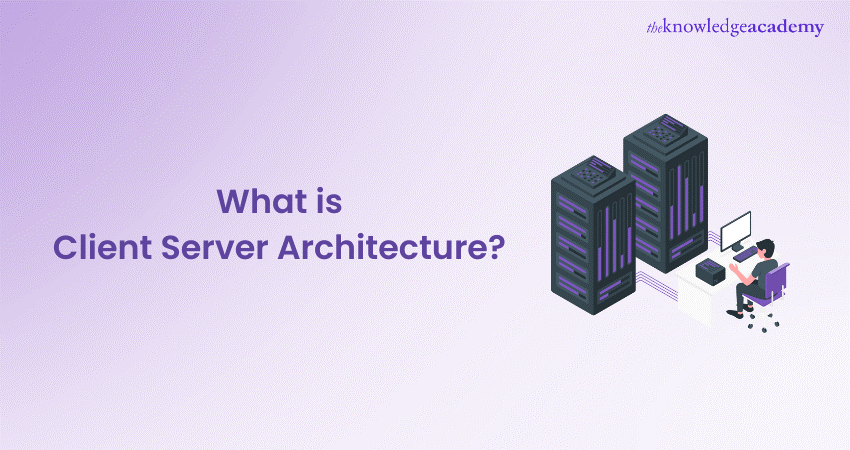
The IT field is always changing and introducing new technologies that need to be integrated into the network. To stay ahead, IT professionals have to adapt to these changes quickly. To cope with this pressure, IT professionals use Client Server Architecture, which is a way of organising network resources between clients and servers.
A Client Server Architecture is a network-based computing structure where responsibilities and operations get distributed between clients and servers. Client-Server Architecture is widely used for network applications such as email, web, online banking, e-commerce, etc. In this blog, we will explore Client-Server Architecture, components, types with examples, and how it works.
Table of contents
1) What is Client Server Architecture?
2) What are the components of Client-Server Architecture?
3) How does Client-Server Architecture work?
4) Types of Client-Server Architecture
5) Conclusion
What is Client Server Architecture?
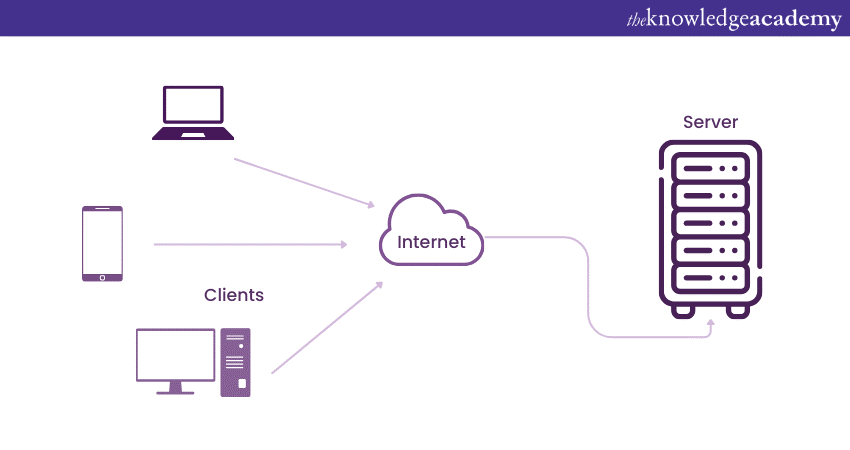
Client-Server Architecture is a network model that allows different applications to exchange data and communicate over a network.
This model divides the system into two parts: a client and a server.
The client is the application that requests services from the server, such as retrieving or storing data, performing calculations, or executing commands.
The server is the application that provides services to the client, such as processing requests, sending responses, or completing actions. The server and the client can be located on the same machine or different devices across the network. The server and the client communicate using a predefined protocol, such as HTTP, FTP, SMTP, etc. Client-Server Architecture is widely used for network applications such as email, web, online banking, e-commerce, etc.
Components of Client-Server Architecture
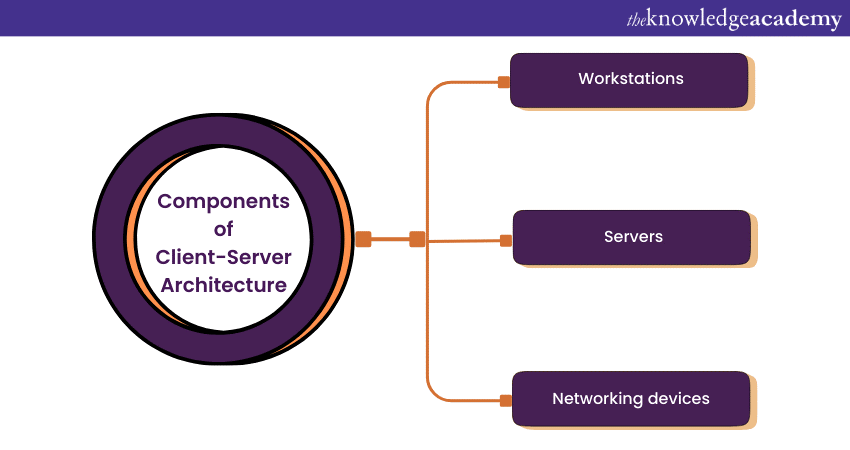
The Client-Server Architecture relies on three interconnected components that are essential for its operation. These components are:
Workstations
Workstations, also known as client machines, are mainly distinguished by the operating systems that run them. Workstation operating systems in a server/ client network include Windows XP, Windows 2000, Windows Vista, and Windows 7. These operating systems are designed primarily for client machines, and they are also cheaper than server operating systems.
They do not have centralised databases, shared software, or administration or security policies. They have local versions of programs and rules that can be applied independently. Workstations also have lower technical requirements than servers in terms of memory, hard drive space, and CPU speed because they do not need to handle requests from multiple machines or store data from multiple machines.
Servers
Servers are identified by different sets of operating systems, such as Windows 2003, Windows 2000 Server or Windows 2008. They also have more hard drive space and memory, as well as faster computers, because they store and handle multiple (and often simultaneous) requests from workstations. A server can play various roles in a client/server network. It can act as a domain controller, file server, mail server, database server, or all four at once.
However, a well-designed network assigns these tasks to different servers to optimise performance. In essence, a server acts as a central repository for network files, programs, databases, and rules, regardless of the role it plays. It simplifies maintenance and backup because it does not depend on individual user settings but can be deployed universally and uniformly across the network.
Networking devices
Each networking device in the Client-Server Architecture has its own function and characteristics.
a) Hubs are used to connect different workstations to a server.
b) Repeaters are used to transfer data from one device to another.
c) Bridges are used to segment isolated networks.
Unlock the power of the cloud with our comprehensive Cloud Computing Training!
How does Client-Server Architecture work?
The basic steps of how Client-Server Architecture works are:
1) In the first step, client sends a request to the server using the network medium. The request can be a query, a command, or a message.
2) In the second step, the server receives the request and processes it according to its logic and data. The server may access its own resources or other servers to fulfil the request.
3) In the third step, server sends a response back to the client using the network medium. The response can be data, an acknowledgement, or an error message.
4) Lastly, client receives the response and displays it to the user or performs further actions based on it.
Types of Client-Server Architecture
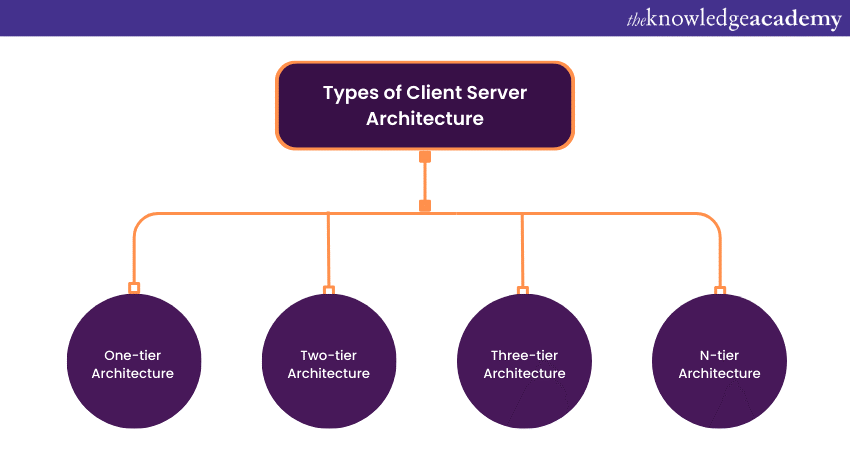
There are different types of Client-Server Architecture, depending on how many tiers or layers are involved in the communication process. Some of the common types are:
One-tier Architecture
This is a software Architecture in which an application is single and self-contained on a single platform. One-tier Architecture is simple and easy to understand, making it a popular choice for small and simple applications.
In one-tier Architecture, the client, the server, and the database are all on the same machine. The client is the application that interacts with the user and performs the business logic. The server is the application that provides services to the client, such as data storage and processing. The database is the software that manages the data for the system.
One-tier Architecture is rarely used in productions as it does not meet the requirements and constraints of most systems.
Two-tier Architecture
This is the simplest type of Client-Server Architecture, where the client directly communicates with the server. There is no intermediate layer between them. The client handles the user interface and the business logic, while the server handles the data storage and processing.
An example of a two-tier Architecture is a web browser and a web server. The web browser requests pages from the web server, which then the web server responds with HTML files. This type of Architecture is easy to implement and maintain, but it has some drawbacks, such as low scalability, high network traffic, and security risks.
Three-tier Architecture
This is a more complex type of Client-Server Architecture, where there is an intermediate layer between the client and the server. The intermediate layer is usually a middleware or an application server that checks the business logic and acts as a bridge between the client and the server. The client handles only the user interface, while the server handles only the data storage and processing.
An example of a three-tier Architecture is an online banking system. The client is a web browser that displays the banking interface, the middleware is an application server that validates transactions and enforces security rules, and the server is a database that stores account information. This type of Architecture improves scalability, performance, and security, but it also increases complexity and cost.
N-tier Architecture
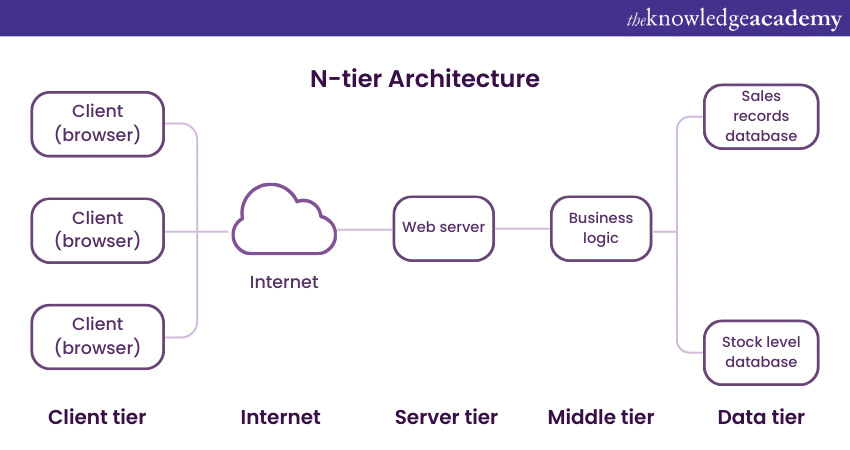
This is a more general type of Client-Server Architecture, where there can be more than three tiers or layers involved in the communication process. The n-tier Architecture allows for greater scalability, flexibility, and modularity of the system. Each tier or layer can be distributed across multiple machines or networks and can be replaced or updated independently.
An example of an n-tier Architecture is an e-commerce system. The client is a web browser that displays the product catalogue, the first middleware is a web server that handles HTTP requests, the second middleware is an application server that processes business logic and communicates with other services, and the server is a database that stores product information. This type of Architecture can handle complex and dynamic systems, but it also requires more resources and management.
In addition to these types, there are also some variations or subtypes of Client-Server Architecture, such as:
Peer-to-peer Architecture
This is a type of Client-Server Architecture where each node can act as both a client and a server. There is no central authority or hierarchy in this type of network. Each node can request or provide services to other nodes directly.
An example of a peer-to-peer Architecture is a file-sharing system such as BitTorrent. The nodes can download or upload files from each other without relying on a central server. This type of Architecture enhances reliability, availability, and resilience, but it also poses challenges such as security, coordination, and quality control.
Thin-client Architecture
This is a type of Client-Server Architecture where the client has minimal functionality and relies on the server for processing and data storage. The client only handles the user interface and sends user inputs to the server. The server performs all the computations and returns the results to the client.
An example of a thin-client architecture is a Cloud Computing system such as Google Docs. The client is a web browser that accesses the online document editor while the server stores and updates the document data on the cloud. This type of architecture reduces hardware costs, maintenance efforts, and security risks on the client side, but it also increases network dependency, bandwidth consumption, and server load.
Fat-client architecture
This is a type of Client-Server Architecture where the client has high functionality and performs most of the processing and data storage locally. The client only communicates with the server occasionally for synchronisation or backup purposes. The server acts as a repository or a backup for the client data.
An example of a fat-client architecture is an offline mobile app such as Evernote. The client is a mobile device that runs the app locally, and stores notes on its memory, while the server syncs and backs up notes on the cloud when connected to the internet. This type of architecture improves performance, responsiveness, and availability on the client side, but it also increases hardware requirements, software complexity, and data inconsistency risks.
Unlock the power of OpenStack on Linux – Join our Linux OpenStack Administration Training now and become an OpenStack Administration expert!
Advantages and disadvantages of Client-Server Architecture
Client-Server Architecture has some advantages and disadvantages, depending on the requirements and constraints of the system.
Advantages
Some of the advantages are:
1) It is centralised, which means that all data and services are stored and managed in a single place. This makes it easier to maintain, update, and secure the system.
2) It is cost-efficient, as it requires less hardware and software resources for the client side. The client only needs a network connection and an application or web browser to access the server.
3) It has high performance and low latency, as the server can handle many requests from many clients simultaneously and efficiently.
Disadvantages
Some of the disadvantages are:
1) It has limited scalability, as it depends on the capacity and availability of the server. If the server is overloaded or fails, the system may not function properly or at all.
2) It has high network dependency, as it relies on the network connection between the client and the server. If the network is slow or disrupted, the system may experience delays or errors.
3) It has complex architecture, as it involves multiple components and layers that need to be designed, implemented, and coordinated. The system may also face challenges such as security, synchronisation, and compatibility.
Unlock the power of Microservices: Join our Microservices Architecture Training today and transform your software development!
Conclusion
Client Server Architecture is a powerful and flexible way of managing network resources and applications. It allows IT professionals to handle the challenges of a dynamic and competitive environment, by distributing the workload and responsibilities between clients and servers. Client-Server Architecture also enables the network's scalability, security, reliability, and performance. It is a vital concept for any IT professional to understand and master.
Unlock limitless possibilities in the cloud – elevate your business with Cloud Computing Course today!
Frequently Asked Questions
Upcoming Cloud Computing Resources Batches & Dates
Date
 Cloud Computing Training
Cloud Computing Training
Thu 15th Aug 2024
Thu 5th Dec 2024







 Top Rated Course
Top Rated Course



 If you wish to make any changes to your course, please
If you wish to make any changes to your course, please


